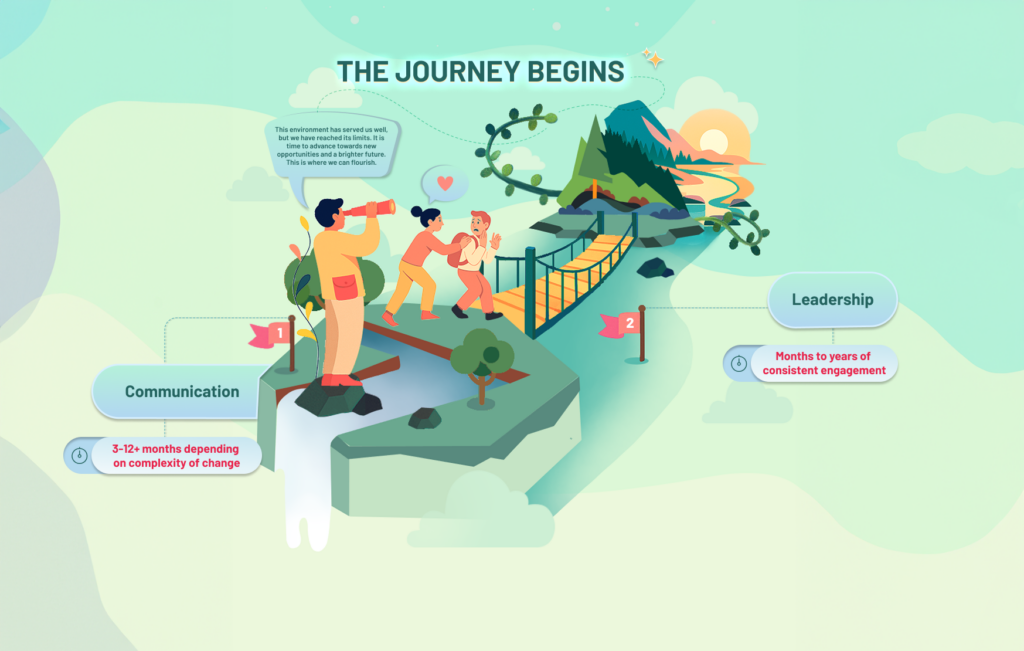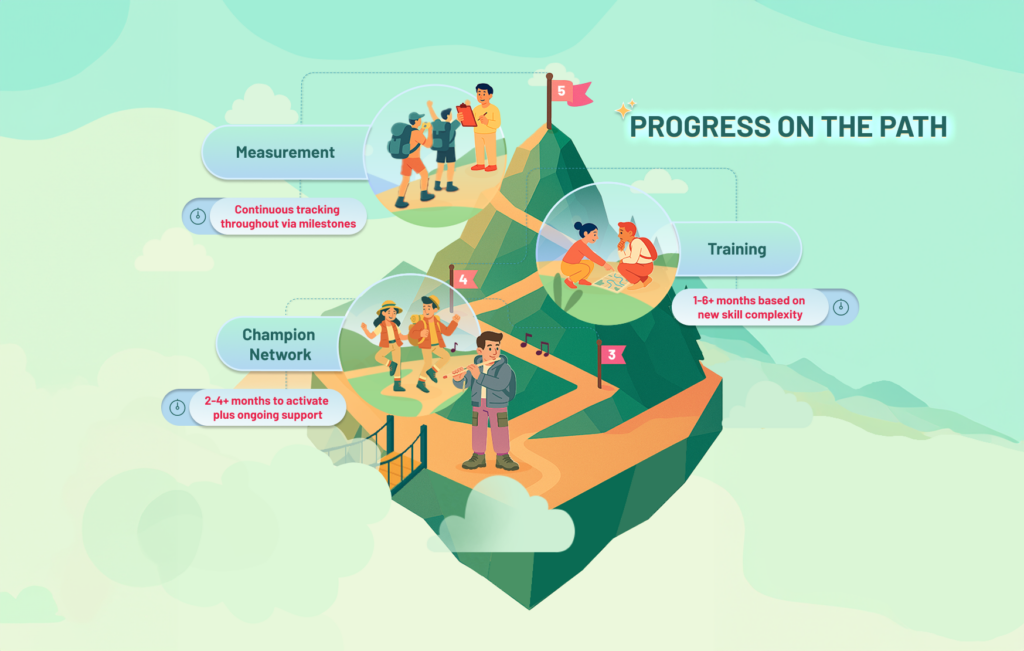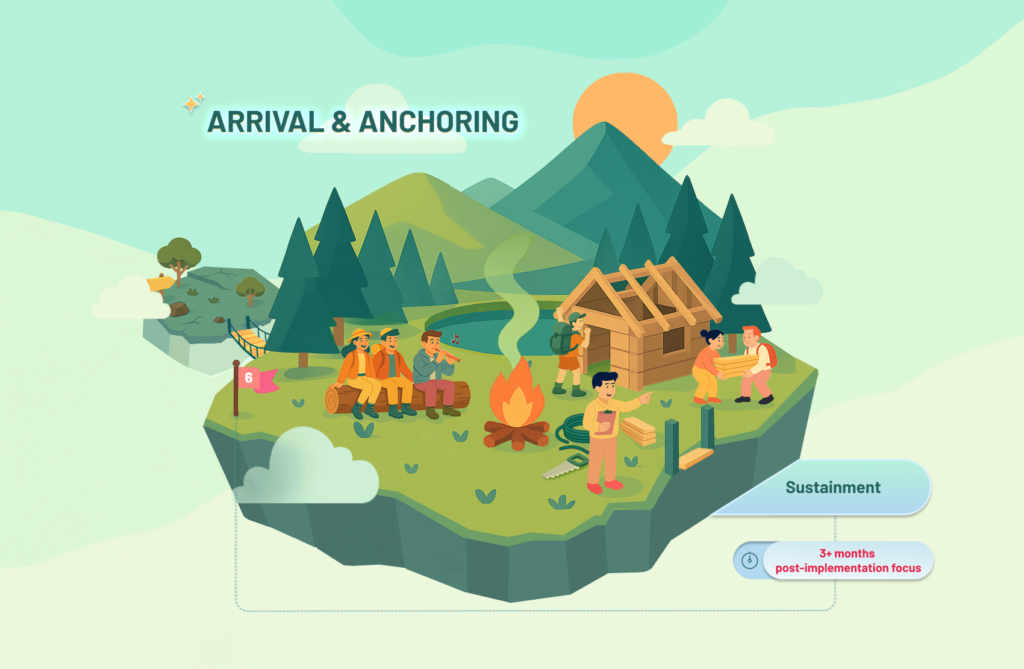By Nilanthi Sangarabalan (Change Management and Communications, FosterWe)
While frameworks like Prosci offer valuable structure, change management is often misinterpreted as a neat, checklist-driven process, which leads to the inaccurate and costly belief that implementing change is a quick, linear sequence of activities. I learned otherwise when tasked with implementing a change strategy for a 2,000-person organization with just two weeks until go-live. That impossible timeline perfectly illustrates the constant underestimation of how much time it truly takes to make change stick. Lasting change isn’t a checklist; it’s a carefully orchestrated transition from an ineffective current state to a desired future.
Let’s explore this journey together. Imagine an organization of 10,000 employees, our travellers, physically moving from an old, uninhabitable environment to a new, better one. This physical journey represents the organization’s transformation.

Element One: Communication
The transformation begins because our current environment no longer serves us effectively; the status quo isn’t viable for our future. While leadership knows the destination and its benefits, our 10,000 employees remain comfortable and unclear on why they need to adjust. This makes awareness communication critical. Effective communication isn’t just about what we say, but when and how. To truly bring everyone along, leadership must clearly articulate the current environment’s shortcomings and paint a compelling vision of the new one well in advance (weeks, even months, before the journey begins). This requires a multi-faceted action plan with diverse tactics (e.g. all-company meetings, cascading messages through leaders, feedback mechanisms) to ensure the message captures attention, is heard, and is understood. If leaders struggle to articulate this vision, coaching them beforehand is also a crucial early investment.
Time Commitment: 3-12+ months depending on the scale and complexity and leader experience
Element Two: Leadership
The importance of leaders in guiding their team members to the desired future cannot be overstated.They chart the course, provide direction, ensure resources are available, and, where needed, actively walk back and encourage their team members to continue travelling forward when worry and resistance start to show. Change is often leader-led. Therefore, leaders must dedicate consistent time to actively engage with their teams, acknowledging any hesitations, providing clear and consistent reassurance about the benefits of new ways of working, and supporting every one of their team members in reaching it, whether they manage a team of 10 or 100. In the real world, this doesn’t happen in a day; this happens over the course of a few weeks or months, during team meetings, regular individual check-ins and bespoke moments where resistance needs to be addressed. Are you beginning to see how the time investment is starting to add up?
Time Commitment: a few months through to multiple years for enterprise strategy transformations

Element Three: Change Champion Network – The Grassroots
Along our journey, we start to recognize passionate employees who are early advocates of our change and moving quickly – you might already know them from their historical engagement and influence. Could they help us bring the rest of the organization with us? Absolutely! You’ve discovered your change champion community, an invaluable network of engaged employees who will advocate for change within their groups and help their peers to come along on this journey. By reiterating key messages, offering peer-to-peer support, champions can inspire and encourage those around them.
In reality though, discovering and activating this group isn’t as quick as you may expect. You’ll need to define what a champion is, request nominations, filter through applications, define and deliver a kick off program, skill them up to help you with the change and methodically engage them regularly to maintain their energy and momentum.
Time Commitment: 2-4+ months for initial setup, with ongoing time for meetings, support, and communication
Element Four: Training
As our travellers proceed on their journey, it’s key to train them on the new skills they’ll need to fully embody and successfully operate in the new ways of working. Training needs to be relevant and tailored to diverse learning needs. Some people learn by seeing, others by doing, so a variety of methods and ample time for practice before ‘go-live’ day arrives is essential. Additionally, readily accessible resources, like maps and information about our new environment, can act as further support. Think: FAQ documents, online knowledge bases, and dedicated support channels. Don’t forget to utilise your change champion community as well!
Time Commitment: 1-6+ months depending on the complexity and scope of new skills to be learnt
Element Five: Measurement
Along our journey, we need to be consistently checking that we’re achieving milestones as expected. Ideally, ways to check in would have been established before we began to move and regularly monitoring these data points throughout the journey is its own time commitment. This allows us to make adjustments to our strategy. For instance, have we noticed a big lag in people reaching the latest milestone? What’s causing it and what can we do to address it?
Time Commitment: ongoing time allocation throughout the entire transformation, with specific attention around key data collection milestones as they relate to the overall transformation (e.g. every 3 months)

Element Six: Sustainment
Eventually, all 10,000 travellers reach the new, better environment. Is this the end of our change story? Not quite. Even though our employees have made it, the inertia of the old ways of working will linger for a while. To prevent them from returning, we need to reinforce the value of staying in our new environment. This involves consistently monitoring adoption patterns, establishing channels for ongoing feedback to identify areas for refinement, and celebrating both big and small successes that demonstrate progress. Recognizing and rewarding those who champion the new behaviors will further solidify their adoption and encourage others to follow suit, ultimately making the new environment the established one.
Time Commitment: continued time investment post-implementation of at least 3 months
Conclusion
Using the analogy of physically moving your people from one environment to a new one, I’ve aimed to highlight that even a well-defined change management plan is only as good as the time commitment you tie to it. Many of the tactics involved (e.g. communication, resistance support) require ongoing and regular time investment over the course of months and even years, not days. But, it can, and has been done in organizations that take this seriously.
My aim has been to broaden your thinking in this area but, if reading this has left you feeling a little worried about the time investment required for your own organizational transformation and you’d like some extra support or a partner to help, my inbox is always open.












